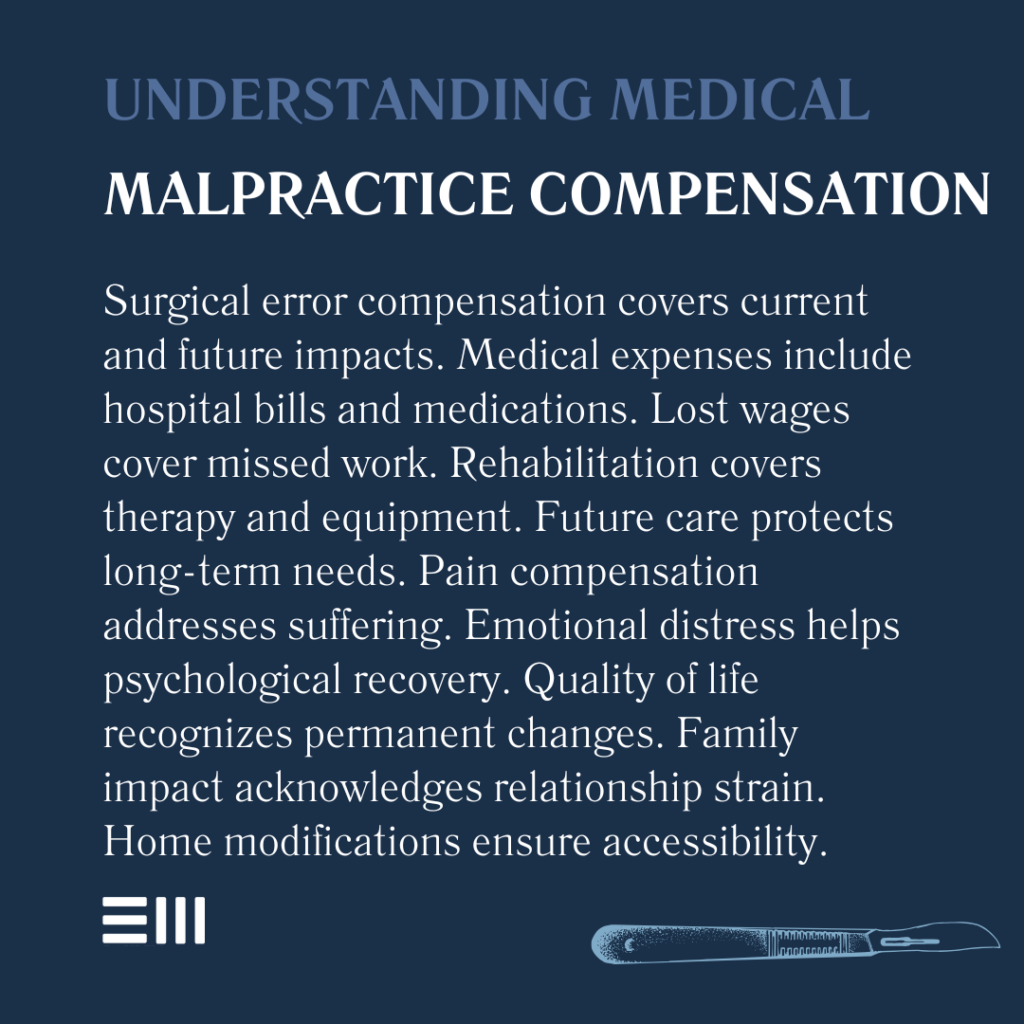
According to a landmark Johns Hopkins study, medical errors are now the third leading cause of death in the United States.
These statistics represent more than just numbers—they represent families whose lives have been forever changed by surgical errors and postoperative complications.
Understanding your rights and options in these situations can make the difference between securing your future and facing mounting medical bills alone.
Common Types of Surgical Errors
Understanding these common mistakes helps patients identify potential malpractice situations and take appropriate action.
- Wrong-site surgery or wrong-patient procedures;
- Anesthesia errors and complications;
- Surgical instruments left inside patients;
- Nerve damage during procedures;
- Unnecessary or unauthorized procedures;
- Infection due to improper sterilization;
- Incorrect incision sites;
- Organ perforation or damage;
- Blood vessel damage; and
- Failure to monitor vital signs.
Each of these errors can have life-altering consequences, making prevention and proper medical protocol adherence essential for patient safety.

Risk Factors and Prevention
Several factors can increase the likelihood of surgical errors, from systemic issues to individual circumstances.
Healthcare providers must implement strict protocols to minimize these risks.
- Poor pre-operative planning;
- Inadequate staff training;
- Communication breakdowns;
- Fatigue and overwork;
- Equipment malfunctions;
- Documentation errors; and
- Time pressure during procedures.
Understanding these risk factors helps both medical professionals and patients work together to prevent adverse outcomes and maintain the highest standards of care.
Postoperative Complications and Their Impact
Studies show that approximately 40% of surgical patients experience some form of postoperative complication, with about half of these cases being potentially preventable through proper care and monitoring.
Critical Postoperative Complications
The hours and days following surgery present unique challenges and risks that require vigilant monitoring and prompt intervention when complications arise.
- Healthcare-associated infections (HAIs);
- Blood clots and embolisms;
- Respiratory complications;
- Medication errors during recovery;
- Reopening of surgical sites;
- Organ damage or failure;
- Sepsis and systemic infections;
- Post-operative bleeding;
- Adverse medication reactions; and
- Chronic pain development.
Early recognition and intervention in these complications can significantly improve patient outcomes and prevent long-term damage.
Long-term Impact Assessment
Surgical complications can have far-reaching effects that extend well beyond the initial recovery period, affecting every aspect of a patient’s life.
- Permanent disability;
- Chronic pain conditions;
- Psychological trauma;
- Reduced quality of life;
- Ongoing medical needs;
- Career limitations; and
- Family life impacts.
Recognizing and documenting these long-term impacts is crucial for ensuring patients receive appropriate compensation and ongoing care support.
Your Legal Rights in Alabama
Alabama law provides specific protections for victims of surgical errors, governed by the Alabama Medical Liability Act (AMLA).
Key Legal Considerations
Understanding the complex framework of Alabama’s medical malpractice laws helps patients protect their rights and pursue appropriate legal action when necessary.
- Two-year statute of limitations for most cases;
- Required expert testimony for malpractice claims;
- Damage caps and limitations;
- Discovery rule applications;
- Notice requirements for healthcare providers;
- Contributory negligence standards;
- Medical review panel requirements; and
- Certificate of merit requirements.
These legal requirements form the foundation for building a strong medical malpractice case in Alabama courts.
Recent Legal Developments
The landscape of medical malpractice law continues to evolve, with recent Alabama Supreme Court decisions reshaping how these cases are handled.
- Modified expert witness requirements;
- Updated causation standards;
- Expanded discovery rules;
- New precedents for damages; and
- Revised informed consent standards.
Staying informed about these legal developments ensures patients can effectively pursue their rights under current Alabama law.
Proving Medical Malpractice in Surgical Error Cases
Successfully proving medical malpractice requires a thorough understanding of both medical standards and legal requirements. Each element must be clearly established through evidence and expert testimony.
Essential Elements of Proof
Building a strong medical malpractice case requires establishing four key elements, each supported by substantial evidence and expert testimony.
- Existence of doctor-patient relationship;
- Deviation from standard of care;
- Direct causation of harm;
- Quantifiable damages;
- Expert medical testimony;
- Documentation of injuries; and
- Evidence of long-term impact.
Each element must be proven with clear, convincing evidence to establish a valid malpractice claim.
Documentation Requirements
Proper documentation forms the backbone of any successful medical malpractice claim, requiring careful collection and preservation of evidence.
- Medical records and charts;
- Surgical notes and reports;
- Post-operative care documentation;
- Witness statements;
- Expert evaluations;
- Treatment timeline records; and
- Financial impact evidence.
Thorough documentation strengthens your case and helps establish the full extent of damages suffered.
Types of Compensation Available
Medical malpractice victims may be eligible for various forms of compensation, designed to address both immediate and long-term impacts of surgical errors.
Economic Damages
Economic damages cover the quantifiable financial losses resulting from medical malpractice, both past and future.
- Current medical expenses;
- Future medical care costs;
- Lost wages and benefits;
- Lost earning capacity;
- Rehabilitation expenses;
- Medical equipment needs; and
- Home modification costs.
These damages can be calculated with reasonable certainty based on documentation and expert testimony.
Non-Economic Damages
Non-economic damages address the intangible but significant impacts of surgical errors on quality of life.
- Pain and suffering;
- Emotional distress;
- Loss of enjoyment of life;
- Physical impairment;
- Disfigurement;
- Loss of consortium; and
- Mental anguish.
While harder to quantify, these damages represent real and significant impacts on victims’ lives.

Common Questions About Surgical Error Claims in Alabama
Understanding the complexities of medical malpractice claims helps patients make informed decisions about their legal options.
Below are answers to frequently asked questions about surgical error cases in Alabama.
How Long Do I Have to File a Medical Malpractice Claim in Alabama?
Generally, you have two years from the date of injury to file a medical malpractice claim in Alabama. However, exceptions exist under the discovery rule if the injury wasn’t immediately apparent. The statute of repose sets an absolute deadline of four years in most cases.
What Evidence Is Needed to Prove Surgical Error?
Successful claims typically require comprehensive medical records, expert testimony, surgical documentation, witness statements, and evidence of damages. Documentation of the standard of care and how it was breached is particularly crucial.
How Much Is My Surgical Error Case Worth?
Case value depends on factors including injury severity, long-term impact, medical costs, lost wages, and pain and suffering. While Alabama caps some damages, each case is evaluated individually based on its specific circumstances and evidence.
What if Multiple Healthcare Providers Were Involved?
Multiple parties may be held liable, including surgeons, anesthesiologists, nurses, and hospitals. Each party’s role and responsibility will be evaluated to determine liability and appropriate compensation.
How Long Does a Medical Malpractice Case Usually Take?
Cases typically take 1-3 years to resolve, depending on complexity, evidence availability, and whether settlement is possible. Some cases resolve more quickly through settlement, while others may require extended litigation.
Will My Insurance Cover Medical Costs During the Case?
Your health insurance should continue covering medical care while your case proceeds. However, they may place a lien on any future settlement to recover their costs. Understanding these arrangements is important for case planning.
What if I Signed a Consent Form?
Signing a consent form doesn’t waive your rights in cases of negligence or malpractice. These forms acknowledge known risks but don’t protect against preventable errors or negligent care.
Each medical malpractice case presents unique challenges and considerations, making professional legal guidance essential for protecting your rights.
Secure Your Future: Get Expert Legal Support Now
The aftermath of a surgical error can feel overwhelming, but you don’t have to face it alone. Our experienced medical malpractice attorneys have helped numerous Alabama families secure the compensation they deserve.
Contact us today for a free, confidential consultation to discuss your case and understand your options.
Can't find what you're looking for? Search our site below.










